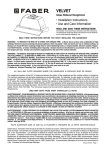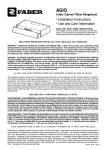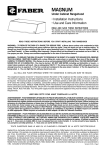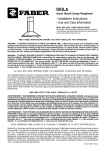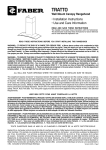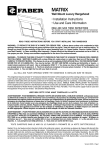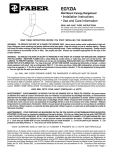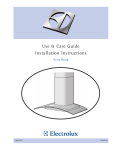Download Faber CRISTAL HC User's Manual
Transcript
CRISTAL HC Slideout Rangehood • Installation Instructions • Use and Care Information READ AND SAVE THESE INSTRUCTIONS The Installer must leave these instructions with the homeowner. The homeowner must keep these instructions for future reference and for local electrical inspectors' use. READ THESE INSTRUCTIONS BEFORE YOU START INSTALLING THIS RANGEHOOD WARNING: - TO REDUCE THE RISK OF A RANGE TOP GREASE FIRE: a) Never leave surface units unattended at high settings. Boilovers cause smoking and greasy spillovers that may ignite. Heat oils slowly on low or medium setting. b) Always turn hood ON when cooking at high heat or when flambeing food (i.e. Crepes Suzette, Cherries Jubilee, Peppercorn Beef Flambé). c) Clean ventilating fans frequently. Grease should not be allowed to accumulate on fan or filter. d) Use proper pan size. Always use cookware appropriate for the size of the surface element. WARNING: - TO REDUCE THE RISK OF INJURY TO PERSONS IN THE EVENT OF A RANGE TOP GREASE FIRE, OBSERVE THE FOLLOWING: SMOTHER FLAMES with a close-fitting lid, cookie sheet, or metal tray, then turn off the burner. BE CAREFUL TO PREVENT BURNS. If the flames do not go out immediately EVACUATE AND CALL THE FIRE DEPARTMENT. NEVER PICK UP A FLAMING PAN - You may be burned. DO NOT USE WATER, including wet dishcloths or towels - a violent steam explosion will result. Use an extinguisher ONLY if: 1. You know you have a Class ABC extinguisher, and you already know how to operate it. 2. The fire is small and contained in the area where it started. 3. The fire department is being called. 4. You can fight the fire with your back to an exit. ALL WALL AND FLOOR OPENINGS WHERE THE RANGEHOOD IS INSTALLED MUST BE SEALED. This rangehood requires at least 24" of clearance between the bottom of the rangehood and the cooking surface or countertop. This minimum clearance may be higher depending on local building code. For example, for gas ranges, a minimum of 30" may be required. The maximum depth of overhead cabinets is 13". Overhead cabinets on both sides of this unit must be a minimum of 18" above the cooking surface or countertop. Consult the cooktop or range installation instructions given by the manufacturer before making any cutouts. MOBILE HOME INSTALLATION The installation of this rangehood must conform to the Manufactured Home Construction and Safety Standards, Title 24 CFR, Part 3280 (formerly Federal Standard for Mobile Home Construction and Safety, Title 24, HUD, Part 280). Four wire power supply must be used and the appliance wiring must be revised. See Electrical Requirements. LISEZ BIEN CETTE FICHE AVANT D'INSTALLER LA HOTTE AVERTISSEMENT - POUR MINIMISER LE RISQUE DʼUN FEU DE GRAISSE SUR LA TABLE DE CUISSON : a) Ne jamais laisser un élément de la table de cuisson fonctionner sans surveillance à la puissance de chauffage maximale; un renversement/ débordement de matière graisseuse pourrait provoquer une inflammation et le génération de fumée. Utiliser toujours une puissance de chauffage moyenne ou basse pour le chauffage dʼhuile. b) Veiller à toujours faire fonctionner le ventilateur de la hotte lors dʼune cuisson avec une puissance de chauffage élevée ou lors de la cuisson dʼun mets à flamber (i.e. Crepes Suzette, Cherries Jubilee, Peppercorn Beef Flambé). c) Nettoyer fréquemment les ventilateurs dʼextraction. Veiller à ne pas laisser de la graisse sʼaccumuler sur les surfaces du ventilateur ou des filtres. d) Utiliser toujours un ustensile de taille appropriée. Utiliser toujours un ustensile de taille adapté à la taille de lʼélément chauffant. AVERTISSEMENT: - POUR PRÉVENIR LES BLESSURES EN CAS DE FEU SUIVRE LES RECOMMANDATIONS SUIVANTES: ÉTOUFFEZ LE FEU avec un couvercle métallique et fermez le brûleur. Si le feu ne s'éteint pas tout de suite, QUITTEZ LES LIEUX ET APPELEZ LES POMPIERS. NE TOUCHEZ JAMAIS UNE CASSEROLE EN FLAMMES. N'UTILISEZ JAMAIS DE L'EAU ou un torchon mouillé pour éteindre le feu - ce qui pourrait causer une explosion de vapeur. N'utilisez un extincteur que si: 1. Vous avez un modèle ABC et vous connaissez bien son mode d'emploi. 2. Le feu est petit et peu répandu. 3. Les pompiers sont déjà prévenus. 4. Vous avez une sortie derrière vous. TOUTE OUVERTURE DANS LE MUR OU LE PLANCHER À PROXIMITÉ DE LA HOTTE DOIT ÊTRE SCELLÉ Gardez 24 po. de hauteur entre le bas de la hotte et la surface de cuisson. Cette hauteur minimum peut être plus haute suivant le code municipal. Par exemple, les cuisinières à gaz peuvent requérir 30 po. de hauteur. Les armoires au-dessus ne dépasseront pas 13 po. de profondeur. Les armoires au-dessus de chaque côté devront être au moins à 18 po. au-dessus de la surface de cuisson. Consultez la fiche technique avant de découper les armoires. L'installation de cette hotte doit être conforme aux Réglements de Manufactured Home Construction and Safety Standards, titre 24 CFR, Section 3280 (anciennement Federal Standard for Mobile Home Construction and Safety Standards, titre 24 CFR, Section 3280 (anciennement Federal Standard for Mobile Home Construction and Safety, titre 24, HUD, Section 280). Le branchement électrique se fait avec une raccordement à 4 fils. Consultez la fiche technique électrique. Version 10/05 - Page 1 VENTING REQUIREMENTS Determine which venting method is best for your application. Ductwork can extend either through the wall or the roof. The length of the ductwork and the number of elbows should be kept to a minimum to provide efficient performance. The size of the ductwork should be uniform. Do not install two elbows together. Use duct tape to seal all joints in the ductwork system. Use caulking to seal exterior wall or floor opening around the cap. Flexible ductwork is not recommended. If it is used, each foot of flexible ductwork used is equivalent to two feet of straight metal ductwork when calculating the ductrun length. Thus, a flexible elbow equals two standard elbows. Make sure there is proper clearance within the wall or floor for exhaust duct before making cutouts. Do not cut a joist or stud unless absolutely necessary. If a joist or stud must be cut, then a supporting frame must be constructed. FOR MORE SPECIFIC DUCTWORK INFORMATION, GO TO PAGE 5. WARNING - To Reduce The Risk Of Fire, Use Only Metal Ductwork. ! WARNING • Venting system MUST terminate outside the home. • DO NOT terminate the ductwork in an attic or other enclosed space. • DO NOT use 4" laundry-type wall caps. • Flexible-type ductwork is not recommended. • DO NOT obstruct the flow of combustion and ventilation air. • Failure to follow venting requirements may result in a fire. ELECTRICAL REQUIREMENTS A 120 volt, 60 Hz AC-only electrical supply is required on a separate 15 amp fused circuit. A time-delay fuse or circuit breaker is recommended. The fuse must be sized per local codes in accordance with the electrical rating of this unit as specified on the serial/rating plate located inside the unit near the field wiring compartment. THIS UNIT MUST BE CONNECTED WITH COPPER WIRE ONLY. Wire sizes must conform to the requirements of the National Electrical Code, ANSI/NFPA 70 - latest edition, and all local codes and ordinances. Wire size and connections must conform with the rating of the appliance. Copies of the standard listed above may be obtained from: National Fire Protection Association Batterymarch Park Quincy, Massachusetts 02269 For residential use only. This appliance should be connected directly to the fused disconnect (or circuit breaker) through flexible, armored or nonmetallic sheathed copper cable. Allow some slack in the cable so the appliance can be moved if servicing is ever necessary. A UL Listed, 1/2" conduit connector must be provided at each end of the power supply cable (at the appliance and at the junction box). When making the electrical connection, cut a 1 1/4" hole in the wall. A hole cut through wood must be sanded until smooth. A hole through metal must have a grommet. WARNING - TO REDUCE THE RISK OF FIRE OR ELECTRIC SHOCK, do not use this fan with any solid-state speed control device. WARNING - TO REDUCE THE RISK OF FIRE, ELECTRICAL SHOCK, OR INJURY TO PERSONS, OBSERVE THE FOLLOWING: Use this unit only in the manner intended by the manufacturer. If you have any questions, contact the manufacturer. Before servicing or cleaning unit, switch power off at service panel and lock the service disconnecting means to prevent power from being switched on accidentally. When the service disconnecting means cannot be locked, securely fasten a prominent warning device, such as a tag, to the service panel. CAUTION: For General Ventilating Use Only. Do Not Use To Exhaust Hazardous or Explosive Materials and Vapors. WARNING - TO REDUCE THE RISK OF FIRE, ELECTRICAL SHOCK, OR INJURY TO PERSONS, OBSERVE THE FOLLOWING: Installation Work And Electrical Wiring Must Be Done By Qualified Person(s) In Accordance With All Applicable Codes And Standards, Including Fire-Rated Construction. Sufficient air is needed for proper combustion and exhausting of gases through the flue (chimney) of fuel burning equipment to prevent backdrafting. Follow the heating equipment manufacturer's guideline and safety standards such as those published by the National Fire Protection Association (NFPA), and the American Society for Heating, Refrigeration and Air Conditioning Engineers (ASHRAE), and the local code authorities. When cutting or drilling into wall or ceiling, do not damage electrical wiring and other hidden utilities. Ducted fans must always be vented to the outdoors. ! WARNING • Electrical ground is required on this rangehood. • If cold water pipe is interrupted by plastic, nonmetallic gaskets or other materials, DO NOT use for grounding. • DO NOT ground to a gas pipe. • DO NOT have a fuse in the neutral or grounding circuit. A fuse in the neutral or grounding circuit could result in electrical shock. • Check with a qualified electrician if you are in doubt as to whether the rangehood is properly grounded. • DO NOT use this appliance with any solid state fan speed control device. • Failure to follow electrical requirements may result in a fire. Version 10/05 - Page 2 RÈGLEMENTS D'ÉVACUATION Confirmer la sortie d'évacuation - soit par le mur, soit par le toit. Utilisez une longueur de tuyauterie minimale avec les moindres de coudes pour la plus grande efficacité. Le diamètre de tuyauterie doit être uniforme. N'installez jamais 2 coudes ensemble. Scellez bien tous les joints avec un ruban adhésif métallique à l'intérieur et scellez bien le clapet extérieur avec du calfeutrage. Utilisez un tuyau d'évacuation rigide lorsque possible. Un tuyau flexible égale deux fois plus qu'un tuyau rigide, ce qui réduit la puissance d'évacuation. Veillez à ce que l'espace pour le tuyau soit ample - ainsi on n'aurait pas besoin de découper les supports de mur intérieur. Si ce découpage est nécessaire, veillez bien à ce qu'un renforcement soit mis en place. RÈGLEMENTS D'ÉVACUATION ADDITIONELL PAGE 10. AVERTISSEMENT - Pour Ne Pas Risquer Un Feu, Utilisez Seulement Les Matériaux Métalliques. ! AVERTISSEMENT • Le système d'évacuation DOIT sortir à l'extérieur. • N'ÉVACUEZ PAS le conduit soit dans une mansarde soit dans un espace enfermé. • N'UTILISEZ PAS un clapet de séchoir à 4 pouces. • N'utilisez pas un conduit flexible. • N'ENCOMBREZ PAS la circulation d'air. • Faute de suivre cet avertissement pourrait occasionner un feu. FICHE TECHNIQUE ÉLECTRIQUE Le raccordement électrique doit se faire avec un circuit séparé de 15 ampères fusible à 120V, 60 Hz, courant alternant. On recommande un coupe-circuit. La taille du fusible doit se conformer aux codes municipaux suivant la spécification électrique sur la plaque intérieure. Le diamètre du fil devra aussi se conformer aux règlements du code national électrique, ANSI/NFPA 70 - ainsi qu'aux règlements locaux et les spécifications de cet appareil. On peut obtenir ces informations chez: l'Association Nationale de la Prévention du Feu Batterymarch Park Quincy, Massachusetts 02269 Raccordez cet appareil directement au coupe-circuit avec un fil flexiblle couvert en cuivre en laissant un peu de lâchement dans le fil pour permettre le déplacement de l'appareil. Veillez a ce qu'un contact d'un demi-pouce (1/2 po.) soit installé à chaque bout de fil (soit à l'appareil ainsi qu'à la boite à fusible). Faites un trou de 1 1/4 po. dans le mur. S'il s'agit d'un trou en bois - sablez-le bien, tandis qu'un trou passant par le métal demande un bouche-trou. AVERTISSEMENT - POUR RÉDUIRE LE RISQUE D'INCENDIE OU DE CHOC ELECTRIQUE, ne pas utiliser ce ventilateur en conjonction avec un dispositif de réglage de vitesse à semi-conducteurs. AVERTISSEMENT – POUR MINIMISER LES RISQUES DʼINCENDIE, CHOC ÉLECTRIQUE OU DOMMAGES CORPORELS, OBSERVER LES PRESCRIPTIONS SUIVANTES: Suivez les recommandations du fabricant et entre en communication avec lui pour toute information. Fermez le courant avant tout entretien et veillez a ce qu'il reste fermé. Si on ne peut pas verrouiller le panneaux du service électrique, affichez un avis de danger sur la porte. AVIS: Pour L'évacuation Générale - Veillez à Ne Pas Evacuer Des Matériaux Ou Vapeurs Explosif. AVERTISSEMENT – POUR MINIMISER LES RISQUES DʼINCENDIE, CHOC ÉLECTRIQUE OU DOMMAGES CORPORELS, OBSERVER LES PRESCRIPTIONS SUIVANTES: L'installation Et Le Raccordement Electrique Doivent Se Faire Par Un Technicien Qualifié Selon Tous Les Codes Municipaux. Afin d'obtenir un rendement maximal en ce qui a trait à la combustion ainsi qu'à l'évacuation des gaz par la conduite de cheminée, une bonne aération est nécessaire pour tous les appareils à combustion. Suivez les conseils et mesures de sécurité du fournisseur tels que ceux publiés par l'Association Nationale de la Sauvegarde contre l'Incendie et l'Association Américaine d'Ingénieurs de Chauffage, Frigorifaction et Air Climatisé ainsi que les codes municipaux. En perçant un mur veillez à ne pas perforer un autre fil électrique. Une ventilateur à évacuation extérieure doit être raccordée à l'extérieur. ! AVERTISSEMENT • Une prise à terre est nécessaire pout cette hotte. • N'utilisez pas un tuyau à l'eau froide pour la mise à terre s'il est branché à un joint plastique, nonmétallique ou autre. • NE JOIGNEZ PAS la mise à terre à conduit de gaz. • N'INSTALLEZ PAS un fusible dans le circuit de mise à terre - ce qui peut causer une secousse électrique. • Vérifiez avec un électricien certifié à ce que la hotte soit bien mise à terre. • Faute de suivre ces recommandations pourrait occasionner un feu. Uniquement pour usage menager. Version 10/05 - Page 3 CRISTAL HC DIMENSIONS CUT-OUT Pre-Planning Your Installation - Important: The recommended height to install this hood off the cooktop is a minimum of 24" and a maximum of 30” for maximum effectiveness. Also consult the cooktop manufacturerʼs recommendation. FRONT TRIM OPTIONS The Cristal HC comes with a white front strip installed. Optional black and brushed aluminum strips are included in the box. For a custom front strip, a local cabinet shop can make a strip to match your cabinets. CUSTOM FRONT TRIM DIMENSIONS 1 15/32" 29 7/8" or 35 7/8" 3/4" Version 10/05 - Page 4 TOOLS NEEDED FOR INSTALLATION • Saber Saw or Jig Saw • Drill • 1 1/4" Wood Drill Bit • Pliers • Phillips Screwdriver • Wire Stripper or Utility Knife • Metal Snips • Measuring Tape or Ruler • Level • Pencil • Caulking Gun • Duct Tape PLAN THE DUCTWORK The Cristal HC slideout rangehood is designed to offer wide flexibility of installations. The rangehood can be ducted vertically or horizontally through a 6" round vent. The unit can also be installed in a recirculating configuration. The unit comes standard in the top venting position. FIGURES 1 and 2 show vertical and horizontal installations for this unit. FIGURE 3 shows recirculating installation. PARTS SUPPLIED FOR INSTALLATION • 1 Backdraft Damper • 1 Vent Grate (for recirculating installations only) • 3 front trims, white (already installed), black, and brushed aluminum • 1 Vinyl Trim • 1 Literature Package PARTS NEEDED FOR INSTALLATION • 2 Conduit Connectors • Power Supply Cable • 1 Wall or Roof Cap • All Metal Ductwork OPTIONAL ACCESSORIES AVAILABLE • Charcoal Filters For non-vented installations only, replace charcoal filters as needed part # 6093034 The Cristal HC requires 6" round ductwork. To ensure that the blower performs to its highest possible capacity, ductwork should be as short and straight as possilbe. The ductrun should not exceed 35 feet if ducted with the required minimum of 6" round duct. Calculate the length of the ductwork by adding the equivalent feet in FIGURE A for each piece of duct in the system An example is given in FIGURE B. For best results, use no more than three 90° elbows. Make sure that there is a minimum of 24" of straight duct between elbows if more than one is used. Do not install two elbows together. If you must elbow right away, do it as far away from the hood's exhaust opening as possible. VERTICAL DUCTING HORIZONTAL DUCTING FIGURE 1 FIGURE 2 45˚ Elbow 90˚ Elbow 90˚ Flat Elbow Wall Cap 3.0 feet 5.0 feet 12.0 feet 0.0 feet FIGURE A 9 Feet Straight Duct 9.0 feet 2 - 90˚ Elbows 10.0 feet Wall Cap 0.0 feet Total System 19.0 feet FIGURE B For direct rear venting (FIGURE 2), you must change the blower position. Remove the 12 screws that hold the metal housing to the rangehood body. Remove the 4 screws that hold the blower housing to the metal housing. Rotate the blower 90 degrees toward the back and then flip it over 180 degrees. Be sure that the power supply cable is properly positioned. Replace all screws, making sure that they are firmly fastened. RECIRCULATING INSTALLATIONS For recirculating installations (FIGURE 3), Charcoal Filters are necessary. Remove all four grease filters and set aside. Attach one charcoal filter to each end of the blower. Each charcoal filter attaches to the black grid on the side of the blower. Rotate the filter clockwise to install and counterclockwise to remove (FIGURE 3A). Replace all four grease filters. Some ductwork must be installed to exhaust the rangehood back into the kitchen, either at the top of the cabinet or at the face of the soffit. A plastic vent grate (FIGURE 3B) supplied with the rangehood can be used to cover the duct opening. This duct work must not terminate into a dead air space. ceiling soffit vent grate FIGURE 3A vent grate cabinet 6” round duct ceiling cabinet hood 6” round duct hood FIGURE 3B FIGURE 3 Version 10/05 - Page 5 PREPARE THE CABINET 1. Disconnect and move freestanding range from cabinet opening to provide easier access to upper cabinet and rear wall. Put a thick, protective covering over cooktops, set-in ranges or countertops to protect from damage or dirt. 3. The rangehood mounts to the cabinet by two spring loaded brackets, one on each side of the rangehood (FIGURE 6). Lift the rangehood into the cutout opening in the cabinet. Be careful not to damage the cabinet, rangehood or other appliances. 2. Determine and clearly mark with a pencil the center line of the cabinet on the wall and on the underside of the cabinet where the rangehood will be installed. 3. If the cabinet bottom is recessed, wood blocks need to be installed to insure proper alignment with the cabinet bottom. Wood blocks should be flush or recessed 1/16" to 1/8" within the cabinet bottom as indicated in FIGURE 4. FIGURE 4 4. Determine the proper cutouts for the ductwork. Make all necessary cuts in the walls or cabinets for the ductwork. Install the ductwork before mounting the rangehood. 5. Determine and make the proper cutout for the Power Supply Cable. Use a 1 1/4" Drill Bit to make this hole. Run the Power Supply Cable through the wall or cabinet. DO NOT turn on the power until installation is complete. Use caulking to seal around the wire opening. FIGURE 6 4. The spring loaded brackets are factory set to accomodate a thickness between 1 3/16" and 2 1/4". If your cabinet bottom is less than 1 3/16" thick, the spring loaded brackets can be removed and repositioned down from the top setting to the bottom setting by removing the four phillips screws. 5. Tighten the rangehood to the cabinet by rotating the screws with a phillips screw driver. 6. A grey vinyl strip (FIGURE 7) is included to cover the underside of any remaining exposed cabinet. Attach the grey vinyl strip to the bottom of the back of the rangehood with the three screws provided. If necessary, the strip can be cut to fit the cabinet depth. MAKE THE CUT-OUT OPENING (FIGURE 5) WHERE THE RANGEHOOD WILL BE INSTALLED. CUT-OUT VINYL STRIP FIGURE 7 FIGURE 5 INSTALL THE RANGEHOOD 1. Remove the rangehood from the carton and place on a flat surface. Cover the surface to prevent accidental damage. Remove all parts including the backdraft damper, plastic grille and literature package before discarding the carton. Remove the grease filters and set aside. 2. Place the round damper into the exhaust opening of the rangehood and press down. 7. Remove the cover from the field wiring compartment with a phillips screwdriver. Feed the Power Supply Cable through the electrical knockout. Connect the Power Supply Cable to the rangehood cable. Attach the White lead of the power supply to the White lead of the rangehood with a twist-on type wire connector. Attach the Black lead of the power supply to the Black lead of the rangehood with a twist-on type wire connector. Attach the Power Supply Cable grounding lead to the green screw provided. Using the 4 holes provided, screw the field wiring compartment to the wall or cabinet as dictated by your Power Supply Cable location (screws not provided). Replace the cover. 8. Replace the grease filters. Connect the ductwork to the damper and seal all connections. 9. Turn the power supply on. Turn on the blower and light. If the rangehood does not operate, check that the circuit breaker is not tripped or the house fuse blown. If the unit still does not operate, disconnect the power supply and check that the wiring connections have been made properly. Version 10/05 - Page 6 FRONT TRIM OPTIONS The Cristal HC comes with a white front strip installed. Optional black and brushed aluminum strips are included in the box. To change the front strip, remove the three phillips screws located behind the strip (FIGURE 8). If necessary, the front strip can be adjusted by loosening the three phillips screws and sliding the strip up or down. Tighten screws when you have the strip properly placed. B For a custom front strip, a local cabinet shop can make a strip to match your cabinets. The front strip dimensions are given in FIGURE 9. L Visor Front Strip FIGURE 10 Three Screws USE AND CARE INFORMATION FIGURE 8 Rangehood Control Panel All controls are located on the right side of the rangehood. 1 15/32" 29 7/8" or 35 7/8" 3/4" FIGURE 9 WARRANTY & SERVICE All Faber products are warranteed against any defect in materials or workmanship for the original purchaser for a period of 1 year from the date of original purchase. This warranty covers labor and replacement parts. The warranty does not cover consumable parts such as filters and light bulbs. This warranty does not apply if this product has been subjected to faulty installation, misuse, or neglect. This warranty excludes any consequential expense or damage resulting from any use or malfunction of the product. All implied warranties are limited to the duration of this warranty. To obtain warranty service, contact the dealer from whom you purchased the rangehood, or the local Faber distributor. If you cannot identify a local Faber distributor, contact us at (508) 358-5353 for the name of a distributor in your area. Light On/Off Switch TheOn/Off switch for the fluorescent light is located behind the front trim. Moving the switch to the 1 Position turns the light On. Moving the switch to the 0 position turns the light off. Blower Speed Switch B in FIGURE 10 shows the speed control switch for the blower. Moving the switch to the 1 Position turns the blower on LOW. Moving the switch to the 2 Position turns the blower on MEDIUM. Moving the switch to the 3 Position turns the blower on HIGH. Moving the switch to the 0 Position turns the blower off. Automatic Operation As long as the blower and light switches are on, the blower and light will automatically operate when the visor is opened and shut off when the visor is closed. For Best Results Start the rangehood several minutes before cooking to develop proper airflow. Allow the unit to operate for several minutes after cooking is complete to clear all smoke and odors from the kitchen. Cleaning The metal grease filters should be cleaned frequently in hot detergent solution or placed in the dishwasher. Clean exterior surfaces with hot soapy water. Using abrasives and scouring agents can scratch rangehood finishes and should not be used to clean finished surfaces. Replacing the Fluorescent Light To replace the fluorescent light, remove the diffuser clips from both ends of the glass diffuser (L in FIGURE 10) by removing the screws. Carefully slide the glass diffuser all the way to the right. Lower the left end of the glass below the support flange, then remove the glass by sliding it back to the left. Replace the diffuser glass by reversing these directions. Version 10/05 - Page 7 WIRING DIAGRAM / DIAGRAMME DE FILAGE • This rangehood uses Flourescent Lamp Type F33-15W-T8 and Starter Type S2. 177 035 NewCristal • Cette hotte utilise une ampoule fluorescente, type F33-15W-T8 et un déclencheur, type S2. Version 10/05 - Page 8 DIMENSIONS DE LA HOTTE CUT-OUT Planifiez votre installation - Important : La hauteur recommandée pour installer cette hotte au-dessus de la surface de cuisson est dʼun minimum de 24” et dʼun maximum de 30” pour un maximum dʼefficacité. De plus, nous vous recommandons consulter le manuel de recommandations du fabricant de la surface de cuisson. OPTIONS DE LA BANDE FRONTALE La bande frontale instaleé sur la Cristal HC est blanche. Une bande noire et une bande aluminum brossé sont incluses dans la boîte afin d'armoniser selon notre décor. Pour des bandes sur mesure, un marchand dʼarmoires peut fabriquer une bande qui sʼassortira aux armoires. LES DIMENSIONS DE LA BANDE SUR MESURE 1 15/32 po 29 7/8 po or 35 7/8 po 3/4 po Version 10/05 - Page 9 OUTILS NÉCESSAIRES À LʼINSTALLATION • Scie sauteuse ou à découper • Perceuse • Mèche à bois 1 1/4 po • Pinces • Tournevis Phillips • Dénude fil ou couteau tout usage • Pince coupante à fil métallique • Ruban à mesurer ou règle • Niveau • Crayon • Outil à calfeutrage • Ruban à conduit PLAN DU CONDUIT La hotte Cristal HC est conçue pour offrir une grande flexibilité dʼinstallations. Elle peut être installée avec conduit horizontal ou vertical par une ventilation rond de 6 po ou avec une configuration de recirculation dʼair. La hotte arrives avec conduit vertical. Les FIGURES 1 et 2 montrent lʼinstallation avec conduit vertical et horizontal. PIÈCES FOURNIES POUR LʼINSTALLATION • 1 registre à clapet • Une grille (Pour Recirculation D'air) • Les bandes frontale, blanc, noir, et aluminum brossé • 1 nécessaire de documentation PIÈCES NÉCESSAIRES POUR LʼINSTALLATION • 2 connecteurs de conduit • Câble dʼalimentation • 1 capuchon de mur ou de toit • Conduit en métal ACCESSOIRES POUR LʼINSTALLATION • Filtres au Charbon Pour installation sans conduit part # 6093034 La hotte Cristal HC requiert le conduit rond de 6 po. Pour assurer que le ventilateur marche le mieux, le conduit doit être aussi court et aussi droit que possible. La longueur du conduit ne doit jamais excéder 35 pi. Calculer la longueur du conduit en ajoutant lʼéquivalent en pied de la FIGURE A pour chaque pièce du conduit du système. Un exemple est donné à la FIGURE B. Pour de meilleurs résultats, ne pas utiliser plus de trois coudes de 90o. Sʼassurer quʼil y ait un minimum de 24 po de conduit droit entre les coudes si lʼon utilise plus dʼun coude. Ne pas installer deux coudes ensemble. Coude 45˚ Coude 90˚ Coude plat 90˚ Capuchon de mur 3ß,0 pi 5,0 pi 12,0 pi 0,0 pi 9 pi de conduit droit 9,0 pi 2 Coudes 90˚ 10,0 pi Capuchon de mur 0,0 pi Système total FIGURE A CONDUIT VERTICAL 19,0 pi FIGURE B CONDUIT HORIZONTAL FIGURE 1 FIGURE 2 Pour la sortie postérieure de l'air (FIGURE 2) on doit changer la position du diffuseur selon l'ordre des opérations suivantes . Enlever les 12 vis qui fixent la partie mètallique à la carcasse de la hotte. Enlever les 4 vis qui fixent la carcasse du diffuseur à la partie mètallique. Tourner le diffuseur de 90 degrès vers le derrière et renversez à 180 degrès. S' assurer que le cable est positionné correctement. Replacer toutes les vis en s'assurant qu'ils sont parfaitement vissées INSTALLATION POUR RECIRCULATION D'AIR Un nécessaire des Filtres au Charbon (FIGURE 3A) est requis pour ce type d'installation. Installation pour recirculaton d'air requis conduit pour divertir l'air à l'extérieur de l'armoire. Ne la conduit terminez pas dan l'armoire. La grille en plastique fournie avec la hotte peut être utilisée pour couvrir lʼouverture du conduit, tel quʼil est illustré à la (FIGURE 3B). 2. Déterminer et marquer clairement, à lʼaide dʼun crayon, la ligne centrale sur le mur où la hotte sera installée. 3. Si le bas de lʼarmoire est en retrait, il faut installer des montants en bois afin dʼassurer un alignement approprié avec le bas de lʼarmoire. Ces montants en bois doivent être égaux ou en retrait de 1/16 à 1/8 po avec le bas de lʼarmoire, tel quʼil est illustré à la FIGURE 4. montants en bois FIGURE 4 FIGURE 3A FIGURE 3B PRÉPARATION DE L'ARMOIRE 4. Déterminer et faire toutes les coupes nécessaires dans le mur pour les conduits. Installer les conduits avant la hotte. 1. Débrancher et enlever la cuisinière afin dʼavoir un meilleur accès aux armoires supérieures et au mur arrière. Placer un recouvrement épais sur la plaque de cuisson, la cuisinière encastrée ou le dessus du comptoir pour protéger des dommages et de la poussière. 5. Déterminer lʼemplacement approprié pour le câble dʼalimentation. Utiliser une mèche de 1 1/4 po pour faire un trou et y passer le câble dʼalimentation. Utiliser du calfeutrage pour sceller tout autour du trou. NE PAS mettre en circuit tant que lʼinstallation nʼest pas complétée. Version 10/05 - Page 10 CUT-OUT FIGURE 5 DÉCOUPER L'OUVERTURE OÙ LA HOTTE SERA INSTALLÉE (FIGURE 5). INSTALLATION DE LA HOTTE 1. Retirer lʼappareil de la boîte et le déposer sur une surface plate pour lʼassemblage. Couvrir la surface pour éviter tout dommage. Retirer toutes les pièces incluant les le registre à clapet, la grille en plastique, et nécessaire de documentation avant de jeter la boîte. Retirer les filtres pour la graisse de lʼappareil et mettre de côté. 6. Une bande (FIGURE 7) est incorporee dans l' emballage afin de couvrir la partie inferieure a vis de l'armoire. La bande est fixee sur la partie inferieure en bas de la hotte par trois vis . 2. Placer le registre rond dans l'ouverture d'échappement de la hotte et appuyer fortement sur le registre. 3. Installer la hotte sur lʼarmoire à lʼaide de deux fixations à ressort, une de chaque côté de la hotte (FIGURE 6). Placer la hotte dans lʼouverture pratiquée dans lʼarmoire. Attention de ne pas endommager lʼarmoire, la hotte ou dʼautres appareils. 4. Les fixations a ressort sont fournies a la usine afin de contenir une epaisseur compris entre 1 3/16" et 2 1/4". Si le fond de votre armoire est profond moin de 1 3/16" est possible d' enlever les fixations a ressort et les positionnes en bas enlavant le 4 vis. 5. Utiliser un tournevis Phillips et serrer la vis de reglement tandis que les fixations s'attachent fortement à la surface. VINYL STRIP FIGURE 7 7. Retirer le couvercle du compartiment de filage. Passer le câble dʼalimentation dans la pastille enfonçable. Attacher le fil blanc du câble dʼalimentation sur le fil blanc de la hotte avec une cosse. Attacher le fil noir du câble dʼalimentation au fil noir de la hotte avec une cosse. Brancher le fil de mise à la terre vert (jaune et vert) sous la vis de mise à la terre verte. Utiliser les quatre trous fournis et fixer le compartiment de filage au mur ou à l'armoire, déterminé par l'emplacement du câble dʼalimentation (vis non fournies). Replacer le couvercle. 8. Replacer les filtres pour la graisse. 9. Brancher le conduit sur le registre et sceller toutes les connexions avec du ruban à conduit. 10. Mettre lʼalimentation en circuit. Mettre en circuit le ventilateur et la lumière. Si la hotte ne fonctionne pas, vérifier si le disjoncteur nʼest pas fermé ou si le fusible nʼest pas grillé. Si lʼappareil ne fonctionne toujours pas, débrancher lʼalimentation et vérifier si les connexions ont été effectuées correctement. FIGURE 6 Version 10/05 - Page 11 OPTIONS DE LA BANDE FRONTALE La bande frontale instaleé sur la Cristal HC est blanche. Une bande noire et une bande aluminum brossé sont incluses dans la boîte afin d'armoniser selon notre décor. Pour enlever la bande frontale, dévisser les trois vis en retrait situées derrière la bande frontale (FIGURE 8). Si nécessaire, la bande frontale peut être ajustée en désserrant les trois vis en retrait et en la glissant de haut en bas. Resserrer les vis lorsque votre bande est à la place désireé. Pour des bandes sur mesure, un marchand dʼarmoires peut fabriquer une bande qui sʼassortira aux armoires. Les dimensions de la bande avant sont données à la FIGURE 9. B L Decran de verre FIGURE 10 Bande Frontale Trois vis UTILISATION ET ENTRETIEN FIGURE 8 1 15/32" 29 7/8" or 35 7/8" 3/4" FIGURE 9 GARANTIE ET SERVICE Faber garantit à lʼutilisateur-acheteur dʼorigine que les produits Faber vendus neufs par nous sont sans vice de matériel et de main-dʼoeuvre dʼorigine pour une période dʼun an à partir de la date dʼachat. La garantie couvre la main-dʼoeuvre et les pièces de remplacement. Par contre, elle ne couvre pas les pièces reliées à lʼusure normale de lʼappareil (exemple: les filtres et les ampoules). La garantie ne sʼapplique pas si le produit a été mal installé, utilisé dʼune manière inadéquate ou négligé. Cette garantie exclue toutes les dépenses consécutives dûes à des dommages résultant dʼun mauvais fonctionnement du produit. La présente garantie remplace toutes autres garanties et déclarations expresses. Afin dʼobtenir un service sous garantie, communiquer avec le marchand où la hotte a été achetée ou le distributeur Faber de la région. Si lʼon ne peut trouver de distributeur Faber, communiquer avec nous au (508) 358-5353 afin dʼobtenir le nom dʼun distributeur dans la région. Panneau de commandes Toutes les commandes sont situées sous le côté droit arrière de la hotte. Bouton marche-arrêt de la lumière L'interrupteur marche-arrêt pour la lumière fluorescente est située derrière la bande frontale. Régler à « 1 » pour mettre en circuit (ON) et à « O » pour mettre hors circuit (OFF). Bouton de vitesse du ventilateur (B- FIGURE 10) Régler à « 1 » pour vitesse basse (LOW), à « 2 » pour vitesse moyenne (MÉDIUM) et à « 3 » pour vitesse élevée (HIGH). Régler à « 0 » pour mettre hors circuit (OFF). Automatic Operation As long as the blower and light switches are on, the blower and light will automatically operate when the visor is opened and shut off when the visor is closed. Pour de meilleurs résultats Mettre la hotte en circuit avant de commencer la cuisson. Laisser lʼappareil fonctionner quelques minutes après la cuisson pour éliminer la fumée et les odeurs. Nettoyage Nettoyer régulièrement les filtres de métal avec une solution dʼeau chaude et de détergent ou mettre au lave-vaisselle. Nettoyer les surfaces extérieures à lʼeau chaude savonneuse. Ne pas employer de produits abrasifs ou de récurants qui endommagent les surfaces en acier inoxydable. Remplacement de la lumière fluorescente Pour remplacer la lumière fluorescente, enlever les attaches de diffuseur (L - FIGURE 9) aux deux extrémités du diffuseur en verre. Prudemment glisser le diffuseur en verre complètement vers la droite. Abaisser le côté gauche du verre sous le rebord , enlever ensuite le verre en le glissant de nouveau vers la gauche. Replacer le diffuseur en verre en inversant la marche à suivre. Version 10/05 - Page 12
This document in other languages
- français: Faber CRISTAL HC













